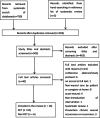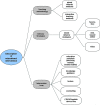Effects of home-based chronic wound care training for patients and caregivers: A systematic review
- PMID: 37277908
- PMCID: PMC10588341
- DOI: 10.1111/iwj.14219
Effects of home-based chronic wound care training for patients and caregivers: A systematic review
Abstract
We aimed to review and synthesise the evidence of the interventions of patients' and informal caregivers' engagement in managing chronic wounds at home. The research team used a systematic review methodology based on an updated guideline for reporting systematic reviews (PRISMA) and recommendations from the Synthesis Without Meta-analysis. Cochrane Central Register of Controlled Trial of the Cochrane Library, Pubmed, Embase, CINAHL, Wanfang (Chinese), and CNKI database (Chinese) were searched from inception to May 2022. The following MESH terms were used: wound healing, pressure ulcer, leg ulcer, diabetic foot, skin ulcer, surgical wound, educational, patient education, counselling, self-care, self-management, social support, and family caregiver. Experimental studies involving participants with chronic wounds (not at risk of wounds) and their informal caregivers were screened. Data were extracted and the narrative was synthesised from the findings of included studies. By screening the above databases, 790 studies were retrieved, and 16 met the inclusion and exclusion criteria. Studies were 6 RCTs and ten non-RCTs. Outcomes of chronic wound management included patient indicators, wound indicators, and family/caregiver indicators. Home-based interventions of patients or informal caregivers' engagement in managing chronic wounds at home may effectively improve patient outcomes and change wound care behaviour. What's more, educational/behavioural interventions were the primary type of intervention. Multiform integration of education and skills training on wound care and aetiology-based treatment was delivered to patients and caregivers. Besides, there are no studies entirely targeting elderly patients. Home-based chronic wound care training was important to patients with chronic wounds and their family caregivers, which may advance wound management outcomes. However, the findings of this systematic review were based on relatively small studies. We need more exploration of self and family-oriented interventions in the future, especially for older people affected by chronic wounds.
Keywords: caregiver; chronic wound; home care; systematic review; wound care training.
© 2023 The Authors. International Wound Journal published by Medicalhelplines.com Inc and John Wiley & Sons Ltd.
Conflict of interest statement
The author(s) declared no potential conflicts of interest with respect to the research, authorship, and/or publication of this article.
Figures
Similar articles
-
Psychological interventions for treating foot ulcers, and preventing their recurrence, in people with diabetes.Cochrane Database Syst Rev. 2021 Feb 8;2(2):CD012835. doi: 10.1002/14651858.CD012835.pub2. Cochrane Database Syst Rev. 2021. PMID: 35653236 Free PMC article.
-
Interventions for patients and caregivers to improve knowledge of sickle cell disease and recognition of its related complications.Cochrane Database Syst Rev. 2016 Oct 6;10(10):CD011175. doi: 10.1002/14651858.CD011175.pub2. Cochrane Database Syst Rev. 2016. PMID: 27711980 Free PMC article.
-
How lived experiences of illness trajectories, burdens of treatment, and social inequalities shape service user and caregiver participation in health and social care: a theory-informed qualitative evidence synthesis.Health Soc Care Deliv Res. 2025 Jun;13(24):1-120. doi: 10.3310/HGTQ8159. Health Soc Care Deliv Res. 2025. PMID: 40548558
-
Topical antimicrobial agents for treating foot ulcers in people with diabetes.Cochrane Database Syst Rev. 2017 Jun 14;6(6):CD011038. doi: 10.1002/14651858.CD011038.pub2. Cochrane Database Syst Rev. 2017. PMID: 28613416 Free PMC article.
-
Education support services for improving school engagement and academic performance of children and adolescents with a chronic health condition.Cochrane Database Syst Rev. 2023 Feb 8;2(2):CD011538. doi: 10.1002/14651858.CD011538.pub2. Cochrane Database Syst Rev. 2023. PMID: 36752365 Free PMC article.
Cited by
-
Trend analysis of pressure ulcers in adults 60 years and older from 1990 to 2021 using jointpoint regression and Bayesian age period cohort models.Sci Rep. 2025 Jul 12;15(1):25198. doi: 10.1038/s41598-025-11027-5. Sci Rep. 2025. PMID: 40652100 Free PMC article.
-
Fatalism as a Mediator of the Association Between Family Resilience and Self-Management Among Patients with Chronic Wounds in China.Patient Prefer Adherence. 2024 Jan 9;18:53-67. doi: 10.2147/PPA.S446219. eCollection 2024. Patient Prefer Adherence. 2024. PMID: 38223440 Free PMC article.
-
The Role of Communication in Managing Chronic Lower Limb Wounds.J Multidiscip Healthc. 2025 Jun 25;18:3685-3708. doi: 10.2147/JMDH.S533416. eCollection 2025. J Multidiscip Healthc. 2025. PMID: 40589782 Free PMC article. Review.
-
To take a different approach: Can large language models provide knowledge related to respiratory aspiration?Digit Health. 2025 Jul 10;11:20552076251349616. doi: 10.1177/20552076251349616. eCollection 2025 Jan-Dec. Digit Health. 2025. PMID: 40656849 Free PMC article.
-
Loss of productivity among caregivers of dependent family members.AIMS Public Health. 2025 Apr 11;12(2):451-469. doi: 10.3934/publichealth.2025025. eCollection 2025. AIMS Public Health. 2025. PMID: 40697259 Free PMC article.
References
Publication types
MeSH terms
Grants and funding
LinkOut - more resources
Full Text Sources
Medical
Miscellaneous







